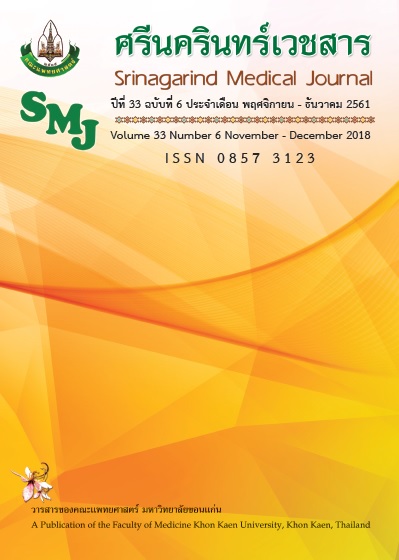Level of Happiness and Model of Enhancing Happiness in Working Of Health Personnels at Yasothon Provincial Public Health Office
Keywords:
happiness level; model of enhancing happiness; Yasothon provinceAbstract
Background and objectives: The dissatisfaction of working is resulted to the decrease of efficiency, quality and unhappiness in working. This research aims to study 1) level of happiness and develop a model of enhancing happiness in working of health personnel 2) factors related to the level of happiness in working health personnel.
Methods: This study is survey research focus on a group of health personnel in public health office, Yasothon province. Four hundred and eleven of working health was calculated by using proportion estimation, stratified random sampling and collecting data by interviewed. The precision of questionnaire is 0.87. Data analysis was occurred by using chi-square test, Pearson product moment correlation and multiple regression.
Results: 1)Level of happiness in working was found at high level (mean=3.68, S.D=0.57). 2)Factors related to happiness in working were knowledge, capability, attitude, facility and environment. These factors was able to forecast at p<.001 (Constant=1.053; SEconst=+.180 R=.610; adjR2=.366; F=61.010). 3)Models of enhancing happiness include (1)fulfill basic factors with orientation, preceptor system, obvious of job assignments, remunerating system, and facility, (2)strengthening of structure with well-being and morale, empower, progression, construction of surrounding in working with sibling system and group of the profession care system and (3)assigning tasks, which have challenged has ultimately valued.
Conclusions: Health personnel are so happy in working at high levels. The model of enhancing happiness in working of health personnel should improve including 7 elements such as good orientation, good mentor, good compensation, good facilities, good progress, good relationship and good assignment.
References
2. Cowin LS, Hengstberger-Sims C. New graduate nurse self-concept and retention: A longitudinal survey. Int J Nurs Stud 2006; 43: 59-70.
3. ชนิกา ตู้จินดา. Happy 8 Workplace ความสุข 8 ประการในที่ทำงาน. [อินเตอร์เน็ต]. [เข้าถึงเมื่อ 28 มกราคม 2560]. เข้าถึงได้จาก: http://www.thaihealth.or.th/node/12827, 2552.
4. Gavin JH, Mason RO. The Virtuous Organization: The Value of Happiness in the Workplace. Organization Dynamics 2004; 33: 379-92.
5. สุกัญญา รัศมีธรรมโชติ. Employee Engagement in Practices ผูกใจพนักงานอย่างไรให้ได้ทั้งใจทั้งงาน. กรุงเทพฯ : แผนกประมวญความรู้ ฝ่ายส่งเสริมการเพิ่มผลผลิต สถาบันเพิ่มผลผลิตแห่งชาติ, 2556.
6. ประชาไท. TCIJ: ตรวจสอบ 10 เหตุผล ‘แพทย์ไหลออกจาก รพ.รัฐ’. [อินเตอร์เน็ต]. [เข้าถึงเมื่อวันที่ 11 มีนาคม 2560]. เข้าถึงได้จาก: http://pracha tai.com /journal/ 2017 /01/69824.
7. กรมอนามัย กองทันตสาธารณสุข. รายงานจํานวนทันตบุคลากรประจําปี 2552. (เอกสารอัดสําเนา), 2552.
8. ฝ่ายการพยาบาล คณะแพทยศาสตร์ โรงพยาบาลรามาธิบดี. ข้อมูลจํานวนบุคลากรทางการพยาบาล. ณ วันที่ 20 สิงหาคม พ.ศ. 2555.
9. ปริศนา ใจบุญ, ประสิทธิ์ เชียงนางาม และ ปิยธิดา คูหิรัญญรัตน. สัดส่วนและสาเหตุการลาออกของพยาบาลที่ปฏิบัติงานในโรงพยาบาลศรีนครินทร์ คณะแพทยศาสตร์ มหาวิทยาลัยขอนแก่น. ศรีนครินทร์เวชสาร 2554; 26: 233-8.
10. สำนักงานสาธารณสุขจังหวัดยโสธร. สรุปผลการดำเนินงานสาธารณสุขประจำปี 2560. สำนักงานสาธารณสุขจังหวัดยโสธร: ยโสธร, 2560.
11. วีรญา ศิริจรรยาพงษ์, ปิยธิดา ตรีเดช และสุคนธา ศิริ. ความสุขในการทางานของพยาบาลวิชาชีพในหอผู้ป่วยใน โรงพยาบาลรามาธิบดี. วชิรสารการพยาบาล 2556; 15: 1-16.
12. ฐิตินันท เขียวนิล. ระดับความสุขในที่ทํางานของบุคลากรสายสนับสนุน มหาวิทยาลัยราชภัฏเชียงใหม่. เชียงใหม่: คณะคุรุศาสตร มหาวิทยาลัยราชภัฏเชียงใหม่, 2554.
13. ปยวรรณ มาศผล, สุมิตร สุวรรณ. การศึกษาระดับความสุขในการทำงานตามทรรศนะของบุคลากร กรณีศึกษา บริษัท อุตสาหกรรมถุงพลาสติคไทย จํากัด อําเภอสามพราน จังหวัดนครปฐม. การประชุมวิชาการ ครั้งที่ 8 มหาวิทยาลัยเกษตรศาสตร วิทยาเขตกําแพงแสน 8-9 ธันวาคม 2554. นครปฐม: มหาวิทยาลัยเกษตรศาสตร วิทยาเขตกําแพงแสน, 2554; 414-22.
14. สิรินทร แซ่ฉั่ว. ความสุขในการทำงานของบุคลากรเชิงสร้างสรรค์. For Quality People 2010; 17: 106-12.
15. John W. Best, James V. Kahn, Research in Education. 5th ed. New Jersey. Prentice-Hall. 1986.
16. ณัฐวรรณ แสงอุรัย. ความสัมพันธ์ระหว่างความพึงพอใจในงาน ความผูกพันต่อองค์กร และความตั้งใจที่จะลาออกจากงาน ของบุคลากรโรงพยาบาลสมุทรสาคร. วารสารวิชาการสาธารณสุข 2558; 24: 760-8.
17. โสรยา เฉลยจิต และคณะ. ปัจจัยที่มีผลต่อการคงอยู่ของทันตแพทย์ในสังกัดกระทรวงสาธารณสุขภาคตะวันออกเฉียงเหนือของทันตแพทย์ การประชุมวิชาการมหาวิทยาลัยกรุงเทพ ครั้งที่ 1 วันที่ 29 กรกฎาคม 2554; 2554: 331-48.
18. ชาญวิทย์ วสันต์ธนารัตน์. Change… เพื่อสร้างความสุขในองค์กร. [อินเตอร์เน็ต]. [เข้าถึงเมื่อ 20 มกราคม 2560]. เข้าถึงได้จาก: http://www.wiseknow.com/blog/2009/05/22/2534/#axzz1XM0jYg4j, 2553.
19. สุพานี สฤษฎ์วานิช. พฤติกรรมองค์การสมัยใหม่: แนวคิดและทฤษฎี. พิมพ์ครั้งที่ 2. ปทุมธานี: โรงพิมพ์มหาวิทยาลัยธรรมศาสตร์, 2552.
20. สร้อยตระกูล อรรถมานะ. พฤติกรรมองค์การ: ทฤษฎีและการประยุกต์. พิมพ์ครั้งที่ 3. กรุงเทพมหานคร: สำนักพิมพ์มหาวิทยาลัยธรรมศาสตร์, 2545.



